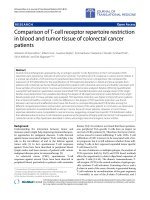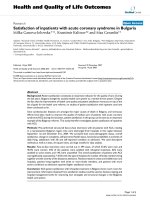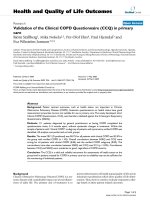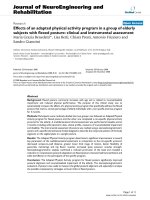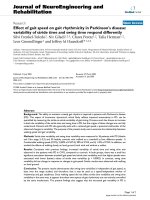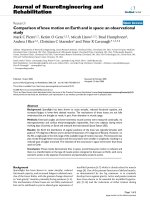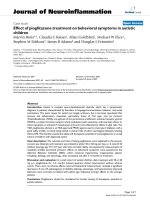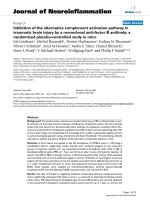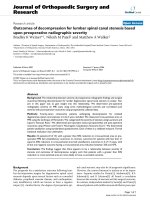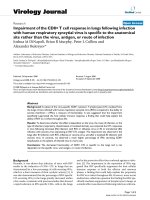Báo cáo hóa học: " Grafting of 4-(2,4,6-Trimethylphenoxy)benzoyl onto Single-Walled Carbon Nanotubes in Poly(phosphoric acid) via Amide Function" pot
Bạn đang xem bản rút gọn của tài liệu. Xem và tải ngay bản đầy đủ của tài liệu tại đây (614 KB, 7 trang )
NANO EXPRESS
Grafting of 4-(2,4,6-Trimethylphenoxy)benzoyl onto Single-Walled
Carbon Nanotubes in Poly(phosphoric acid) via Amide Function
Sang-Wook Han Æ Se-Jin Oh Æ Loon-Seng Tan Æ
Jong-Beom Baek
Received: 15 December 2008 / Accepted: 2 April 2009 / Published online: 5 May 2009
Ó to the authors 2009
Abstract Single-walled carbon nanotubes (SWCNTs),
which were commercial grade containing 60–70 wt%
impurity, were treated in a mild poly(phosphoric acid)
(PPA). The purity of PPA treated SWCNTs was greatly
improved with or without little damage to SWCNTs
framework and stable crystalline carbon particles. An
amide model compound, 4-(2,4,6-trimethylphenoxy)benz-
amide (TMPBA), was reacted with SWCNTs in PPA with
additional phosphorous pentoxide as ‘‘direct’’ Friedel–
Crafts acylation reaction to afford TMPBA functionalized
SWCNTs. All evidences obtained from Fourier-transform
infrared spectroscopy, Raman spectroscopy, thermogravi-
metric analysis, scanning electron microcopy, and trans-
mission electron microscopy strongly supported that the
functionalization of SWCNTs with benzamide was indeed
feasible.
Keywords Single-walled carbon nanotube Á Purification Á
Grafting Á Polyphosphoric acid Á Phosphorous pentoxide
Introduction
Single-walled carbon nanotubes (SWCNTs) are theoreti-
cally expected to display outstanding mechanical strength,
chemical inertness, and excellent thermal and electrical
conductivities [1, 2]. However, as-prepared SWCNTs
contain a large amount of impurities such as small-sized
catalytic metal particles and carbonaceous materials [3, 4].
They also have difficulty in efficient dispersion to display
maximum enhanced properties. Because of their strong
intrinsic lateral van der Waals attraction, SWCNTs form
bundles that are strictly entangled ( />Thus, the preparation and purification of SWCNTs are
equally important for manufacturing efficiencies in prac-
tice. There are still a few fundamental issues needed to be
resolved first before developing applications. They are
related to: (i) cost-effective synthesis with high purity, and
(ii) easy purification without or less damaging SWCNTs.
Many processes for the synthesis of SWCNTs have been
reported [4]. However, as-prepared SWCNTs contain more
than 60–70 wt% of impurities regardless what method is
used ( Aside from developing
viable SWCNT production on an industrial scale, the
purification and functionalization of SWCNTs continue to
be important in nanomaterial research and development
efforts, thus, it would be of practical interest to be able to
develop a scalable, one-pot process for purification and
functionalization at the same time in a non-destructive mild
medium. Hence, many attempts to purify SWCNTs have
been reported by using oxidation in nitric acid [5], burning
in air [6], using steam [7], etc. However, some reports have
pointed out that significant damage in such harsh condi-
tions has apparently occurred on the sidewall of SWCNTs
such as sidewall opening, breaking, etc. [8–10]. Thus, the
purification and functionalization without or little damage
S W. Han Á S J. Oh
School of Chemical Engineering, Chungbuk National
University, Cheongju, Chungbuk 361-763, South Korea
L S. Tan
Nanostructured and Biological Materials Branch, Materials
and Manufacturing Directorate, AFRL/RXBN, Air Force
Research Laboratory, Wright-Patterson Air Force Base,
Dayton, OH 45433-7750, USA
J B. Baek (&)
Ulsan National Institute of Science and Technology (UNIST),
194, Banyeon, Ulsan 689-805, South Korea
e-mail:
123
Nanoscale Res Lett (2009) 4:766–772
DOI 10.1007/s11671-009-9308-8
on SWCNT framework are prerequisites to maintain and
transfer its outstanding properties to corresponding matrix
as nanoscale additives. As a result, the maximum effective
aspect ratio, which is largely determined by the state of
dispersion, could be achieved. In addition, the chemical
modification of SWCNTs, which is able to diminish lateral
interaction between SWCNTs and also to improve chemi-
cal affinity between SWCNT and matrix, would be a viable
approach to help efficient dispersion.
We have developed the purification of SWCNTs in a
mild and non-destructive medium in PPA. Specifically,
commercial grade PPA (83% P
2
O
5
assay) with additional
amount of phosphorous pentoxide (P
2
O
5
) medium was
optimized condition for ‘‘direct’’ Friedel–Crafts acylation
reaction using a carboxylic acid instead of the corre-
sponding acid chloride [11]. The medium appears to be an
ideal system to exploit both purification and functionali-
zation in a one-pot process. The PPA reaction medium,
which has moderately acidic and viscous characteristics, is
expected to play two important roles. Its acidic nature
could protonate to promote de-bundling of SWCNTs and
also to decompose pre-existing carbonaceous impurities
and catalytic residues. Its viscous nature would help to
impede reaggregation of SWCNTs after their dispersion.
The reaction condition in PPA/P
2
O
5
medium at 130 °C has
been utilized in both the polymerization of phenoxybenzoic
acids [11] and functionalization of closely related carbon
materials such as vapor-grown multi-walled carbon
nanofibers (MWCNFs) [12, 13] and multi-walled carbon
nanotubes (MWCNTs) [14–18].
In this work, we prepared an ‘‘amide’’ model compound,
4-(2,4,6-trimethylphenoxy)benzamide (TMPBA), which
was treated with SWCNTs in PPA/P
2
O
5
medium. The
covalent attachment of TMPBA onto the surface of
SWCNTs was studied by elemental analysis (EA), Fourier-
transform infrared spectroscopy (FT-IR), Raman spectros-
copy, and thermogravimatric analysis (TGA). In addition,
the morphology of functionalized SWCNTs was verified by
scanning electron microscopy (SEM) and transmission
electron microscopy (TEM).
Experimental
Materials
In this study, all reagents and solvents were purchased from
Aldrich Chemical Inc. and used as received, unless other-
wise mentioned. The 4-(2,4,6-trimethylphenoxy)benzam-
ide was synthesized following the procedure described in a
literature and its melting point was 236–238 °C[19].
Single-walled carbon nanotubes (SWCNTs, 30–40 wt%
purity) were obtained from Hanwha Nanotech Co., LTD,
Seoul, Korea ( />Instrumentation
Fourier-transform infrared (FT-IR) spectra were recorded
on a Jasco FT-IR 480 Plus spectrophotometer. Solid sam-
ples were imbedded in KBr disks. Elemental analysis (EA)
was performed by using a CE Instruments EA1110. The
melting points (mp) were determined on a Mel-Temp
melting point apparatus and are uncorrected. Thermo-
gravimetric analysis (TGA) was conducted both in air and
nitrogen atmospheres with a heating rate of 10 °C/min
using a Perkin–Elmer TGA7. The field emission scanning
electron microscopy (FE-SEM) used in this work was a
LEO 1530FE. A FEI Tecnai G2 F30 S-Twin was used
for the field emission transmission electron microscope
(FE-TEM) study.
PPA Treatment of SWCNTs at 130 °C
In a 250 mL resin flask equipped with a high-torque
mechanical stirrer, nitrogen inlet and outlet, as-received
SWCNTs (1.0 g) and PPA (50 g, 83% P
2
O
5
assay) were
placed and stirred under dry nitrogen atmosphere at 130 °C
for 48 h. After cooling to room temperature, water was
added into the flask. Purified SWCNTs were precipitated as
black powder and collected by suction filtration. The
SWCNTs were Soxhlet-extracted with water for 3 days to
completely remove any residual PPA, and then with
methanol for three more days to remove any organo-solu-
ble low molar mass impurities. Finally, the sample was
freeze-dried under reduced pressure (0.5 mmHg) for 72 h.
Functionalization of SWCNTs with 4-(2,4,6-
Trimethylphenoxy)benzamide (TMPBA)
In a 100 mL resin flask equipped with a high torque
mechanical stirrer, and nitrogen inlet and outlet, custom
synthesized TMPBA (0.5 g, 1.96 mmol), and PPA treated
SWCNTs (0.5 g, 41.6 mmol), and PPA (83% assay, 20 g)
were charged and the mixture was stirred under dried
nitrogen purging at 130 °C for 3 h. Phosphorous pentoxide
(P
2
O
5
, 5.0 g) was then added in one portion. The initially
dark mixture became light brown. The temperature was
maintained at 130 °C for 48 h. After cooling down to room
temperature, water was added. The resulting precipitates
were collected, washed with diluted ammonium hydroxide,
Soxhlet-extracted with water for 3 days and methanol for
3 days, and finally freeze-dried under reduced pressure
(0.05 mmHg) for 72 h to give 0.85 g (88% yield) of black
powdery solid: Anal. Calcd. for C
46.19
H
15
O
2
: C, 90.47%;
Nanoscale Res Lett (2009) 4:766–772 767
123
H, 3.06%. Found: C, 79.76%; H, 2.61%. FT-IR (KBr,
cm
-1
): 1233, 1648, 2919, 2920.
Results and Discussion
Without purification, most of the as-prepared SWCNTs
contain approximately 60–70 wt% of impurities such as
carbonaceous fragments, amorphous carbons, and small
amount of graphite and metal catalysts (wha.
co.kr/). Hence, together with the development of efficient
manufacturing to minimize persistent impurities, the viable
purification of prepared SWCNTs is equally important
approach in the field of SWCNT research area. Unlike
MWCNTs or MWCNFs, SWCNTs consist of single
graphene layer rolled into tubes. SWCNTs are vulnerable
to be damaged on their frameworks and thus, they will
loose their outstanding properties. Thus, as-received
SWCNTs with 30–40 wt% purity treated to remove
impurities in a much less corrosive medium in PPA at
130 ° C for 48 h. As described in the ‘‘Experimental’’
section, the PPA treated SWCNTs were recovered and
rigorously worked up.
The SEM image obtained from as-received SWCNTs
shows bulky particle agglomerates (Fig. 1a), while those
impurities have practically disappeared from the PPA
treated SWCNTs (Fig. 1b). The PPA treated SWCNT
bundles appear much coarser than the as-received ones, and
thus the average diameter of the PPA treated SWCNT
bundles is approximately four times of that of as-received
ones. This is simply because carbonaceous impurities
coated on the surface of the as-received SWCNT bundles
are cleaned up, rendering the surfaces more active (Fig. 1a,
inset). The PPA treated SWCNT bundles are able to make
better lateral contact each other and forms larger bundles.
Apparently, the surface of PPA treated SWCNT bundles is
seamless and smooth, whereas the surface of as-received
SWCNT bundles is furry and rough due to the impurities. It
could be an indication that the larger bundle thickness
implies the higher purity of SWCNTs.
The TEM image of the as-received SWCNTs shows that
there are large portions of carbonaceous and metallic
impurities (Fig. 1c). On the other hand, the PPA treated
SWCNTs show that most of carbonaceous impurities have
been removed, but some entrapped metallic particles are
still present in stable spherical crystalline phases (Fig. 1d,
arrows). Since PPA is not as corrosive as superacids, the
entrapped metallic particles could not be removed without
causing the sidewall opening and breaking of the stable
crystalline carbon particles. This implies that PPA can
selectively destroy the amorphous carbons. Unlike
SWCNTs treated in hydrochloric acid and nitric acid/sul-
furic acid treatments [20–22], there were no broken
SWCNTs in bundles observed in this study. On the basis of
these observations, PPA is indeed a mild and much less
destructive medium for the purification of commercial
grade SWCNTs and thus, SWCNTs could preserve their
structural integrity.
The efficient functionalization of SWCNTs in the same
purification medium might be the most important progress,
Fig. 1 SEM images: a as-
received SWCNTs (1000009,
scale bar is 100 nm); b PPA
treated SWCNTs (1000009,
scale bar is 100 nm). TEM
images: c as-received SWCNTs
(250009); and d PPA treated
SWCNTs (500009)
768 Nanoscale Res Lett (2009) 4:766–772
123
since it could allow a one-pot process. For the ‘‘direct’’
Friedel–Crafts acylation reaction of benzamide instead of
benzoic acid chloride, 4-(2,4,6-trimethylphenoxy)benzam-
ide (TMPBA) was prepared by two step reaction sequences.
It was synthesized via aromatic nucleophilic substitution
reaction between 2,4,6-trimethylphenol and 4-fluoroben-
zonitrile to give 4-(2,4,6-trimethylphenoxy)benzonitrile,
followed by acidic hydrolysis to give overall good yield.
The ‘‘direct’’ Friedel–Crafts acylation reaction between
TMPBA and SWCNTs was carried out to afford TMPBA
grafted SWCNTs (TMPBA-g-SWCNT) in PPA/P
2
O
5
medium at 130 °C (Fig. 2a). After the reaction mixture
had been precipitated in water, the collected product was
completely worked up by Soxhlet-extraction with water for
3 days to completely remove residual PPA. An additional
Soxhlet-extraction was conducted with methanol for 3 days
to ensure the complete removal of any unreacted TMPBA
and low molar mass impurities.
The SEM image of TMPBA-g-SWCNT shows that the
surface of SWCNTs is apparently decorated with cova-
lently bonded moieties (Fig. 2b). Since the expected
product should contain carbonyl groups (Fig. 2a), Fourier-
transform infrared (FT-IR) spectroscopy was used to
monitor the aromatic ketone t(C=O) band. The FT-IR
spectrum of TMPBA-g-SWCNT shows keto-carbonyl
stretching peak at 1648 cm
-1
(Fig. 2c). In addition, the
primary amine bands of TMPBA at 3215 and 3386 cm
-1
have disappeared in the spectrum from TMPBA-g-
SWCNT. The result strongly implies that covalent attach-
ment of TMPBA onto the surface of SWCNT to afford
TMPBA-g-SWCNT. Furthermore, FT-Raman spectra were
taken from PPA treated SWCNTs and TMPBA-g-SWCNT
with 46-mW argon-ion laser (1064 nm) as the excitation
source (Fig. 2d). The radial breathing mode (RBM), which
appears in low frequency, is a powerful indicator to
determine the nanotube diameters [23]. The RBM
frequencies of as-received SWCNTs were 83.36–
160.50 cm
-1
. The values correspond SWCNT diameters of
1.39–2.68 nm by equation, xRBM = 223.75/dt (xRBM is
the RBM frequency in cm
-1
;dt is the SWCNT diameter in
nm) [24]. In comparison with PPA treated SWCNTs and
TMPBA-g-SWCNT, the RBM frequencies of TMPBA-g-
SWCNT were almost identical at 85.29 and 162.43 cm
-1
(Fig. 2d). The diameter values, which correspond well to
PPA/P
2
O
5
130
o
C
(a)
CO
O
CO
O
CO
CO
O
O
CH
3
CH
3
CH
3
CH
3
CH
3
CH
3
CH
3
CH
3
CH
3
CH
3
CH
3
CH
3
OC
O
NH
2
CH
3
CH
3
CH
3
+
Wavenumber (cm
-1
)
1000150020002500300035004000
Transmittance (a.u.)
3386
3215
1641
2919
1247
1648
1233
SWCNT
TMPBA-g-SWCNT
TMPBA
(c)
(d)
(b)
Raman Shift (cm
-1
)
0 200 400 600 800 1000 1200 1400 1600 1800
Intensity (a.u.)
PPA treated SWCNT
TMPBA-g-SWCNT
RBM: 83.36, 160.50
D: 1275
G: 1595
D: 1273
G: 1599
RBM: 85.29, 162.43
Fig. 2 a Functionalization of SWCNTs in PPA/P
2
O
5
at 130 °C; b SEM image of TMPBA-g-SWCNT (1000009, scale bar is 100 nm); c FT-IR
spectra; and d FT-Raman spectra
Nanoscale Res Lett (2009) 4:766–772 769
123
SWCNT diameters of 1.37–2.62 nm. It is a strong indica-
tion that the framework of SWCNTs was not damaged. The
ratio of D/G-band intensity (I
D
/I
G
) depends on the SWCNT
content. The D-band found near 1275 cm
-1
is used to
evaluate the defect density present in the tubular wall
structure and the G-band in the 1550–1600 cm
-1
region of
spectrum is due to the tangential C–C stretching of
SWCNT carbon atoms [25]. The I
D
/I
G
value of the
TMPBA-g-SWCNT was 1.3, which was much lower than
5.0 of the PPA treated SWCNTs (Fig. 2d). The result
indicates that SWCNTs in TMPBA-g-SWCNT are further
purified during the functionalization in PPA/P
2
O
5
reaction
medium. On the basis of combined results from FT-IR and
Raman spectra, it could be tentatively concluded that
TMPBA had been attached to electron deficient SWCNTs
via ‘‘direct’’ Friedel–Crafts acylation reaction to give
TMPBA-g-SWCNT and SWCNTs could be further puri-
fied in the reaction medium.
A TEM image is provided to further confirm covalent
grafting of TMPBA onto SWCNT bundles (Fig. 3a). Clear
stripes in the inner part of SWCNT bundle represent that
SWCNT frameworks are not damaged. The organics coated
on the surface of SWCNT bundle are TMPBA moieties,
which are uniformly decorated on the outer surface.
To obtain char yield and thermooxidative stability, the
samples were heated to 800 °C with ramping rate of 10 °C/
min under air atmosphere during TGA runs (Fig. 3b). The
TGA thermogram of as-received SWCNT shows that the
thermooxidative weight loss occurred in the broad range of
369–593 °C with approximately 57.1% of char yield at
800 ° C (Fig. 3b). The residue at 800 °C in air is expected
to be metallic impurities and stable carbonaceous frag-
ments. The PPA treated SWCNTs displayed the weight
loss in the range 348–607 °C with only 8.1% of char yield
at 800 °C (Fig. 3b). The value was 49 wt% less than that of
as-received SWCNTs. The result suggests that the heavy
Temperature (
o
C)
0 100200300400500600700800
Weight (%)
0
10
20
30
40
50
60
70
80
90
100
110
As-received SWCNT
Purified SWCNT
TMPBA-g-SWCNT
(b)
+
H
3
C
CH
3
H
3
C
O4 C
O
PO
O
OH
O
P
O
NH
2
n 4
++
4 NH
3
O
P
O
P
P
O
O
P
OO
O
OO
O
PO
O
OH
O
P
O
O
n-4 4
H
3
C
CH
3
H
3
C
O4 C
O
+
+
H
3
C
CH
3
H
3
C
OC
O
4 H
3
NPO
O
OH
O
P
O
O
n-4 4
+
H
3
C
CH
3
H
3
C
OC
O
4 H
2
NPO
OH
O
n
C
O
O
C
O
O
C
O
C
O
O
O
CH
3
H
3
C
H
3
C
H
3
C
H
3
C
CH
3
CH
3
H
3
C
CH
3
CH
3
H
3
C
with defective sp
2
and sp
3
C-H
+
(c)
(a)
Fig. 3 a TEM image of TMPBA-g-SWCNT bundle; b TGA thermograms obtained with heating rate of 10 °C/min in air; and c proposed
mechanism of functionalization of SWCNT with benzamide functional group
770 Nanoscale Res Lett (2009) 4:766–772
123
weight metallic impurities and most of the carbonaceous
fragments, which are located at outside of SWCNTs, could
almost completely be eliminated by PPA treatment. On the
other hand, stable crystalline carbon particles are unaf-
fected by PPA. The thermooxidative stability of TMPBA-
g-SWCNT was the best among the samples. It showed the
temperature at which 5 wt% weight loss (T
d5%
) had
occurred at 420 °C. The T
d5%
’s of as-received SWCNTs
and PPA treated SWCNTs were the same at 369 °C, which
was 51 °C lower than that of TMPBA-g-SWCNT. The
weight loss of as-received SWCNTs was gradually started
just above 100 °C, indicating that they contained some
amount of volatile impurities. The enhanced thermooxi-
dative stability of TMPBA-g-SWCNT could due to
defective sp
3
C–H and sp
2
C–H sites were substituted by
aromatic TMPBA. The defects are presumably attributable
to the hydrocarbons, which are used as the major compo-
nents in the feedstock for SWCNT productions [26, 27].
The defects would provide primary sites for ‘‘direct’’ Fri-
edel–Crafts acylation reaction. On the basis of the fore-
going rationalization, we have recently reported for the first
time that ‘‘direct’’ functionalization and grafting onto as-
received vapor-grown MWCNFs are very effective in PPA/
P
2
O
5
medium [12–18]. However, we believe there must be
other type of chemical reaction(s) between SWCNT and
carbonium ion to heavily and uniformly functionalize
entire SWCNT (see Fig. 2b) [19, 28]. The proposed func-
tionalization mechanism of TMPBA onto SWCNTs is
presented in Fig. 3c. The mechanism involves that acylium
ions are generated directly from benzamide groups. These
ions attack SWCNTs and attach to their surfaces. From
combined results, it is fair to say PPA is indeed less
destructive to remove the undesired impurities from com-
mercial grade SWCNTs. PPA with additional P
2
O
5
is also
an efficient medium for covalent attachment of TMPBA
onto SWCNTs.
Conclusions
The purification of SWCNTs and the covalent attachment
of TMPBA onto the surface of SWCNTs were conducted in
a mild and thus less destructive PPA medium. On the basis
of the results, it was confirmed that this medium could
efficiently remove persisted carbonaceous and metallic
impurities in commercial grade SWCNTs with or without
little damage to their framework. In addition, the amide
functionality on TMPBA is versatile for the covalent
functionalization of SWCNTs via a simple one-step
‘‘direct’’ electrophilic substitution reaction. Thus, our
approach points out the convenience of purification and
functionalization of SWCNT to a one-pot manufacturing
process.
Acknowledgments We are grateful to Jeong Hee Lee of Chungbuk
National University for obtaining SEM images. We also thank Asian
Office of Aerospace Research and Development (AFOSR-AOARD),
Korea Science and Engineering Foundation (R01-2007-000-10031-0)
and Chungbuk National University for their financial supports of this
research.
References
1. Y P. Sun, K. Fu, Y. Lin, W. Huang, Acc. Chem. Res. 35, 1096
(2002). doi:10.1021/ar010160v
2. C.A. Mitchell, J.L. Bahr, S. Arepalli, J.M. Tour, R. Krishnamo-
orti, Macromolecules 35, 8825 (2002). doi:10.1021/ma020890y
3. C. Journet, W.K. Maser, P. Bernier, A. Loiseau, M.L. de la
Chapelle, S. Lefrant, P. Deniard, R. Lee, J.E. Fischer, Nature 388,
756 (1997). doi:10.1038/41972
4. J. Li, Y. Zhang, Physica E 28, 309 (2005). doi:10.1016/j.physe.
2005.03.022
5. E. Dujardin, T.W. Ebbesen, A. Krishnan, M.M.J. Treacy, Adv.
Mater. 10, 611 (1998). doi:10.1002/(SICI)1521-4095(199805)
10:8\611::AID-ADMA611[3.0.CO;2-8
6. Z. Shi, Y. Lian, F. Liao, X. Zhou, Z. Gu, Y. Zhang, S. Iijima,
Solid State Commun. 112, 35 (1999). doi:10.1016/S0038-1098
(99)00278-1
7. G. Tobias, D. Shao, C.G. Salzmann, Y. Huh, M.L.H. Green,
J. Phys. Chem. B 110, 22318 (2006). doi:10.1021/jp0631883
8. M. Monthioux, B.W. Smith, B. Burteaux, A. Claye, J.E. Fischer,
D.E. Luzzi, Carbon 39, 1251 (2001). doi:10.1016/S0008-6223
(00)00249-9
9. H. Hu, B. Zhao, M.E. Itkis, R.C. Haddon, J. Phys. Chem. B 107,
13838 (2003)
10. C.G. Salzmann, S.A. Llewellyn, G. Tobias, M.A.H. Ward,
Y. Huh, M.L.H. Green, Adv. Mater. 19, 883 (2007). doi:10.1002/
adma.200601310
11. J B. Baek, L S. Tan, Polymer (Guildf) 44, 4135 (2003). doi:
10.1016/S0032-3861(03)00374-4
12. J B. Baek, C.B. Lyons, L S. Tan, J. Mater. Chem. 14, 2052
(2004). doi:10.1039/b401401d
13. J B. Baek, C.B. Lyons, L S. Tan, Macromolecules 37, 8278
(2004). doi:10.1021/ma048964o
14. H J. Lee, S J. Oh, J Y. Choi, J.W. Kim, J. Han, L S. Tan, J B.
Baek, Chem. Mater. 17, 5057 (2005). doi:10.1021/cm051218t
15. S J. Oh, H J. Lee, D K. Keum, S W. Lee, D.H. Wang, S Y.
Park, L S. Tan, J B. Baek, Polymer (Guildf) 47, 1132 (2006).
doi:10.1016/j.polymer.2005.12.064
16. K. Saeed, S.Y. Park, H J. Lee, J B. Baek, W. Huh, Polymer
(Guildf) 23, 8019 (2006). doi:10.1016/j.polymer.2006.09.012
17. J Y. Choi, S J. Oh, H J. Lee, D.H. Wang, L S. Tan, J B. Baek,
Macromolecules 40, 4474 (2007). doi:10.1021/ma0701282
18. J Y. Choi, W. Huh, L S. Tan, J B. Baek, Polymer (Guildf) 48,
4034 (2007). doi:10.1016/j.polymer.2007.04.073
19. D H. Lim, C.B. Lyons, L S. Tan, J B. Baek, J. Phys. Chem. C
228, 12188 (2008). doi:
10.1021/jp801772r
20. Y. Zhang, Z. Shi, Z. Gu, S. Iijima, Carbon 38, 2055 (2000). doi:
10.1016/S0008-6223(00)00047-6
21. K.B. Shelimov, R.O. Esenaliev, A.G. Rinzler, C.B. Huffman,
R.E. Smalley, Chem. Phys. Lett. 282, 429 (1998). doi:10.1016/
S0009-2614(97)01265-7
22. A.G. Rinzler, J. Liu, H. Dai, P. Nikolaev, C.B. Huffman, F.J.
Rodrigues-Macias, P.J. Boul, A.H. Lu, D. Hetmann, D.T. Colbert,
R.S. Lee, J.E. Fischer, A.M. Rao, P.C. Eklund, R.E. Smalley,
Appl. Phys. A 67, 29 (1998). doi:10.1007/s003390050734
23. U.J. Kim, C.A. Furtado, X. Liu, G. Chen, P.C. Eklund, J. Am.
Chem. Soc. 127, 15437 (2005). doi:10.1021/ja052951o
Nanoscale Res Lett (2009) 4:766–772 771
123
24. S. Bandow, S. Asaka, Y. Saito, A.M. Rao, L. Grigorian, E. Richter,
P.C. Eklund, Phys. Rev. Lett. 80, 3779 (1998). doi:10.1103/
PhysRevLett.80.3779
25. M.S. Dresselhaus, G. Dresselhaus, R. Saito, A. Jorio, Phys. Rep.
409, 47 (2005). doi:10.1016/j.physrep.2004.10.006
26. T. Shimada, H. Yanase, K. Morishita, J. Hayashi, T. Chiba,
Carbon 42, 1635 (2004). doi:10.1016/j.carbon.2004.02.019
27. O.S. Carneiro, J.A. Covas, C.A. Bernardo, G. Calderia, F.W.J.V.
Hattum, J.M. Ting, R.L. Alig, M.L. Lake, Compos. Sci. Technol.
58, 401 (1998). doi:10.1016/S0266-3538(97)00138-3
28. M. Liu, Y. Yang, T. Zhu, Z. Liu, Carbon 43, 1470 (2005). doi:
10.1016/j.carbon.2005.01.023
772 Nanoscale Res Lett (2009) 4:766–772
123
